Mineral Composition Impact on the Thermal Conductivity of Granites Based on Geothermal Field Experiments in the Songliao and Gonghe Basins, China
Abstract
:1. Introduction
2. Site, Experiment, and Rock Mineral Description
2.1. Site
2.2. Experiment
2.2.1. X-ray Diffraction
2.2.2. Thermal Conductivity Scanning (TCS)
2.2.3. Porosity
2.3. Rock Mineral Description
3. Validate against Existing Models
3.1. Geometric Average Model Validation
3.2. Harmonic Average Model Validation
4. Relationship between Mineral Composition and Thermal Conductivity
5. Conclusions
- Minerals such as quartz and feldspar are the main components of granite. For different rock samples, the range of content variation is obvious. Affected by the different thermal conductivity of each mineral, the thermal conductivity of rocks differs greatly.
- There is a certain difference between the calculated value of the geometric mean model and the measured value, and the calculated value is large. When the porosity of the harmonic average model is small, it is relatively consistent. When the porosity is greater, the difference is greater. The calculated value is small overall.
- The harmonic average of mineral content is proposed to calculate the thermal conductivity of the framework. The dry or saturated thermal conductivity of granite uses the geometric average of the thermal conductivity of the skeleton and the thermal conductivity of the fluid or gas. By comparing the average relative errors of these three models, the calculated value of this model is the best fit with the measured value. The model satisfies the engineering accuracy requirements for thermal conductivity.
Author Contributions
Funding
Conflicts of Interest
References
- Demırcı, A.; Görgülü, K.; Durutürk, Y. Thermal conductivity of rocks and its variation with uniaxial and triaxial stress. Int. J. Rock Mech. Min. Sci. 2004, 41, 1133–1138. [Google Scholar] [CrossRef]
- Cheng, W.-L.; Nian, Y.-L.; Li, T.-T.; Wang, C.-L. Estimation of oil reservoir thermal properties through temperature log data using inversion method. Energy 2013, 55, 1186–1195. [Google Scholar] [CrossRef]
- Gao, P.; Zhang, Y.; Yu, Z.; Fang, J.; Zhang, Q. Correlation study of shallow layer rock and soil thermal physical tests in laboratory and field. Geothermics 2015, 53, 508–516. [Google Scholar] [CrossRef]
- Schön, J. Physical Properties of Rocks: A Workbook; Elsevier: Amsterdam, The Netherlands, 2011; Volume 8. [Google Scholar]
- Keller, T.; Motschmann, U.; Engelhard, L. Modelling the poroelasticity of rocks and ice. Geophys. Prospect. 1999, 47, 509–526. [Google Scholar] [CrossRef]
- Aichlmayr, H.T.; Kulacki, F. The effective thermal conductivity of saturated porous media. Adv. Heat Transf. 2006, 39, 377–460. [Google Scholar]
- Tavman, I. Effective thermal conductivity of granular porous materials. Int. Commun. Heat Mass Transf. 1996, 23, 169–176. [Google Scholar] [CrossRef]
- Robertson, E.C.; Peck, D.L. Thermal conductivity of vesicular basalt from Hawaii. J. Geophys. Res. 1974, 79, 4875–4888. [Google Scholar] [CrossRef]
- El Sayed, A.M.A. Thermophysical study of sandstone reservoir rocks. J. Pet. Sci. Eng. 2011, 76, 138–147. [Google Scholar] [CrossRef]
- Walsh, J.; Decker, E. Effect of pressure and saturating fluid on the thermal conductivity of compact rock. J. Geophys. Res. 1966, 71, 3053–3061. [Google Scholar] [CrossRef]
- Schärli, U.; Rybach, L. On the thermal conductivity of low-porosity crystalline rocks. Tectonophysics 1984, 103, 307–313. [Google Scholar] [CrossRef]
- Cho, W.; Kwon, S.; Choi, J. The thermal conductivity for granite with various water contents. Eng. Geol. 2009, 107, 167–171. [Google Scholar] [CrossRef]
- Cho, W.-J.; Kwon, S. Estimation of the thermal properties for partially saturated granite. Eng. Geol. 2010, 115, 132–138. [Google Scholar] [CrossRef]
- Abid, M.; Hammerschmidt, U.; Köhler, J. Temperature and moisture dependent thermophysical properties of Sander sandstone. Int. J. Therm. Sci. 2014, 86, 88–94. [Google Scholar] [CrossRef]
- Clauser, C.; Huenges, E. Thermal conductivity of rocks and minerals. Rock Phys. Phase Relat. Handb. Phys. Constants 1995, 3, 105–126. [Google Scholar]
- Hartmann, A.; Rath, V.; Clauser, C. Thermal conductivity from core and well log data. Int. J. Rock Mech. Min. Sci. 2005, 42, 1042–1055. [Google Scholar] [CrossRef] [Green Version]
- Singh, T.; Sinha, S.; Singh, V. Prediction of thermal conductivity of rock through physico-mechanical properties. Build. Environ. 2007, 42, 146–155. [Google Scholar] [CrossRef]
- Gegenhuber, N.; Schoen, J. New approaches for the relationship between compressional wave velocity and thermal conductivity. J. Appl. Geophys. 2012, 76, 50–55. [Google Scholar] [CrossRef]
- Görgülü, K.; Durutürk, Y.; Demirci, A.; Poyraz, B. Influences of uniaxial stress and moisture content on the thermal conductivity of rocks. Int. J. Rock Mech. Min. Sci. 2008, 45, 1439–1445. [Google Scholar] [CrossRef]
- Merriam, R.; Rieke, H.H., III; Kim, Y.C. Tensile strength related to mineralogy and texture of some granitic rocks. Eng. Geol. 1970, 4, 155–160. [Google Scholar] [CrossRef]
- Ersoy, A.; Waller, M. Textural characterisation of rocks. Eng. Geol. 1995, 39, 123–136. [Google Scholar] [CrossRef]
- Zhang, W.; Sun, Q.; Hao, S.; Geng, J.; Lv, C. Experimental study on the variation of physical and mechanical properties of rock after high temperature treatment. Appl. Therm. Eng. 2016, 98, 1297–1304. [Google Scholar] [CrossRef]
- Li, H.; Li, H.; Wang, K.; Liu, C. Effect of rock composition microstructure and pore characteristics on its rock mechanics properties. Int. J. Min. Sci. Technol. 2018, 28, 303–308. [Google Scholar] [CrossRef]
- Tuğrul, A.; Zarif, I. Correlation of mineralogical and textural characteristics with engineering properties of selected granitic rocks from Turkey. Eng. Geol. 1999, 51, 303–317. [Google Scholar] [CrossRef]
- Fuchs, S.; Förster, A. Rock thermal conductivity of Mesozoic geothermal aquifers in the Northeast German Basin. Geochemistry 2010, 70, 13–22. [Google Scholar] [CrossRef] [Green Version]
- Gao, J.; Zhang, H.J.; Zhang, S.Q.; Chen, X.B.; Cheng, Z.P.; Jia, X.F.; Li, S.T.; Fu, L.; Gao, L.; Xin, H.L. Three-dimensional magnetotelluric imaging of the geothermal system beneath the Gonghe Basin, Northeast Tibetan Plateau. Geothermics 2018, 76, 15–25. [Google Scholar] [CrossRef]
- Kang, J.; Yu, Z.; Wu, S.; Zhang, Y.; Gao, P. Feasibility analysis of extreme learning machine for predicting thermal conductivity of rocks. Environ. Earth Sci. 2021, 80, 455. [Google Scholar] [CrossRef]
- Popov, Y.; Beardsmore, G.; Clauser, C.; Roy, S. Isrm suggested methods for determining thermal properties of rocks from laboratory tests at atmospheric pressure. Rock Mech. Rock Eng. 2016, 49, 4179–4207. [Google Scholar] [CrossRef]
- Wu, S.; Yu, Z.; Kang, J.; Zhang, Y.; Gao, P. Research on the anisotropy of thermal conductivity of rocks in songliao basin, china. Renew. Energy 2021, 179, 593–603. [Google Scholar] [CrossRef]
- Guo, P.; Bu, M.; He, M.; Wang, Y. Experimental investigation on thermal conductivity of clay-bearing sandstone subjected to different treatment processes: Drying, wetting and drying II. Geothermics 2020, 88, 101909. [Google Scholar] [CrossRef]
- Horai, K. Thermal conductivity of rock-forming minerals. J. Geophys. Res. 1971, 76, 1278–1308. [Google Scholar] [CrossRef]
- Fuchs, S.; Balling, N.; Förster, A. Calculation of thermal conductivity, thermal diffusivity and specific heat capacity of sedimentary rocks using petrophysical well logs. Geophys. J. Int. 2015, 203, 1977–2000. [Google Scholar] [CrossRef] [Green Version]
- Chopra, N.; Ray, L.; Satyanarayanan, M.; Elangovan, R. Evaluate best-mixing model for estimating thermal conductivity for granitoids from mineralogy: A case study for the granitoids of the Bundelkhand craton, central India. Geothermics 2018, 75, 1–14. [Google Scholar] [CrossRef]
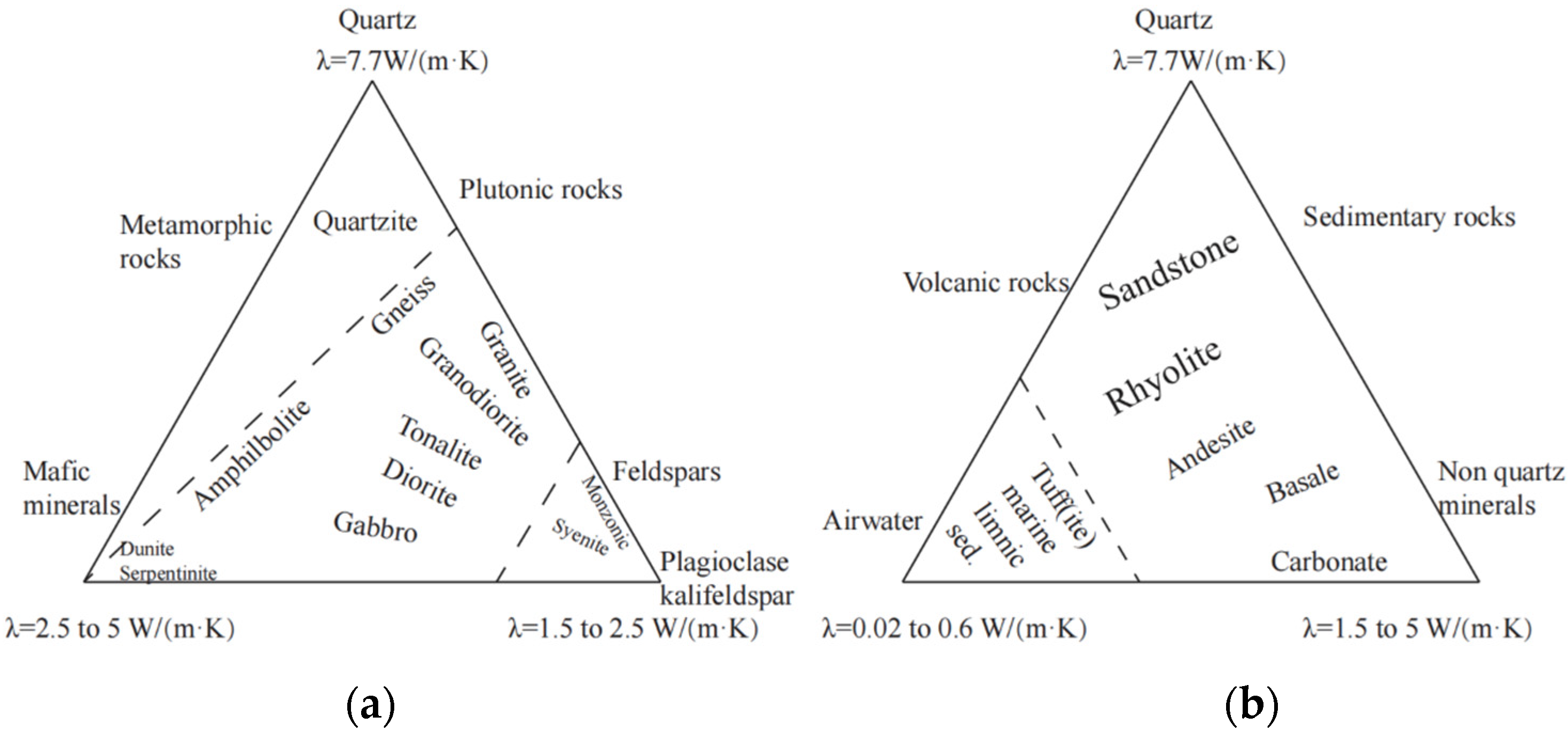
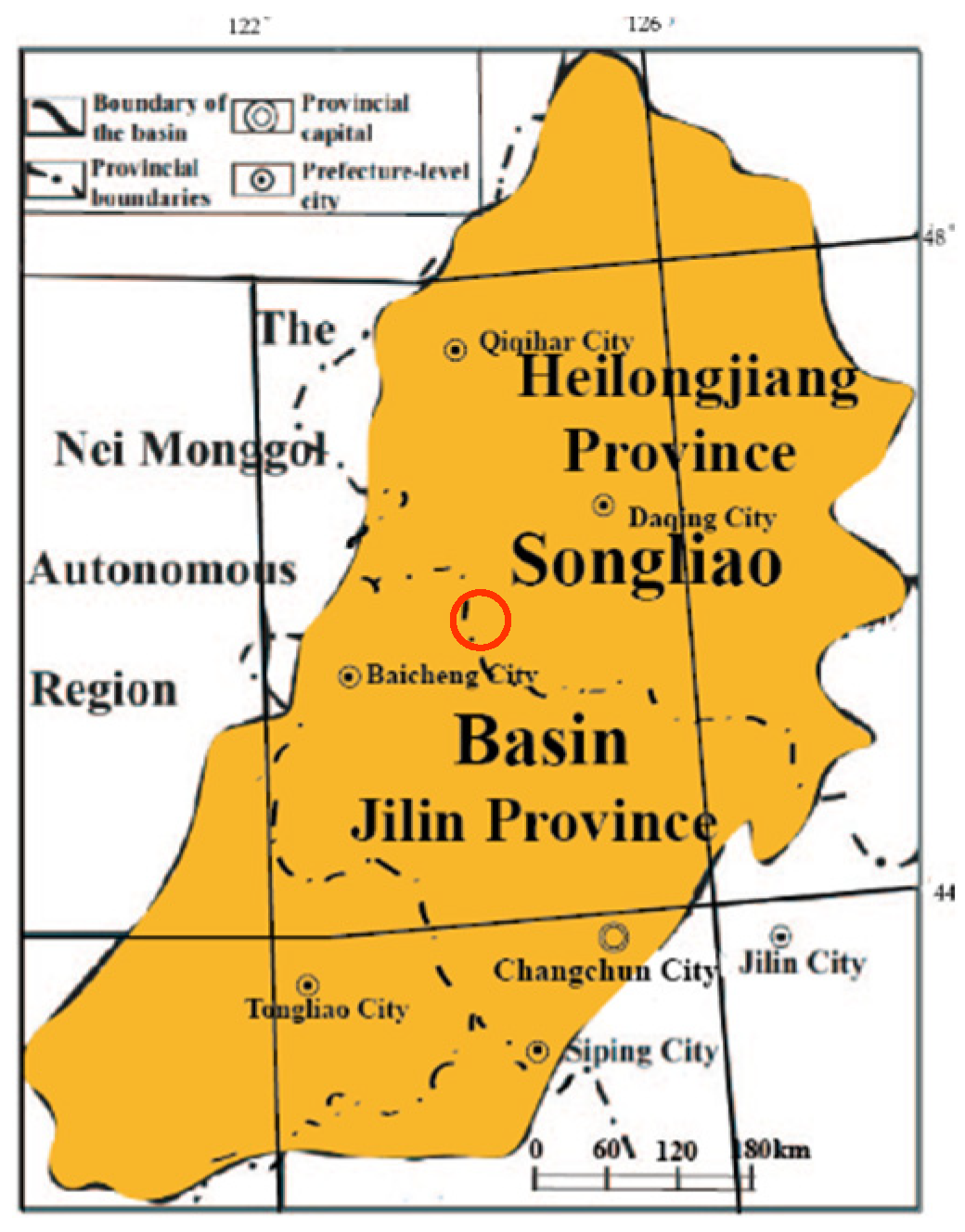
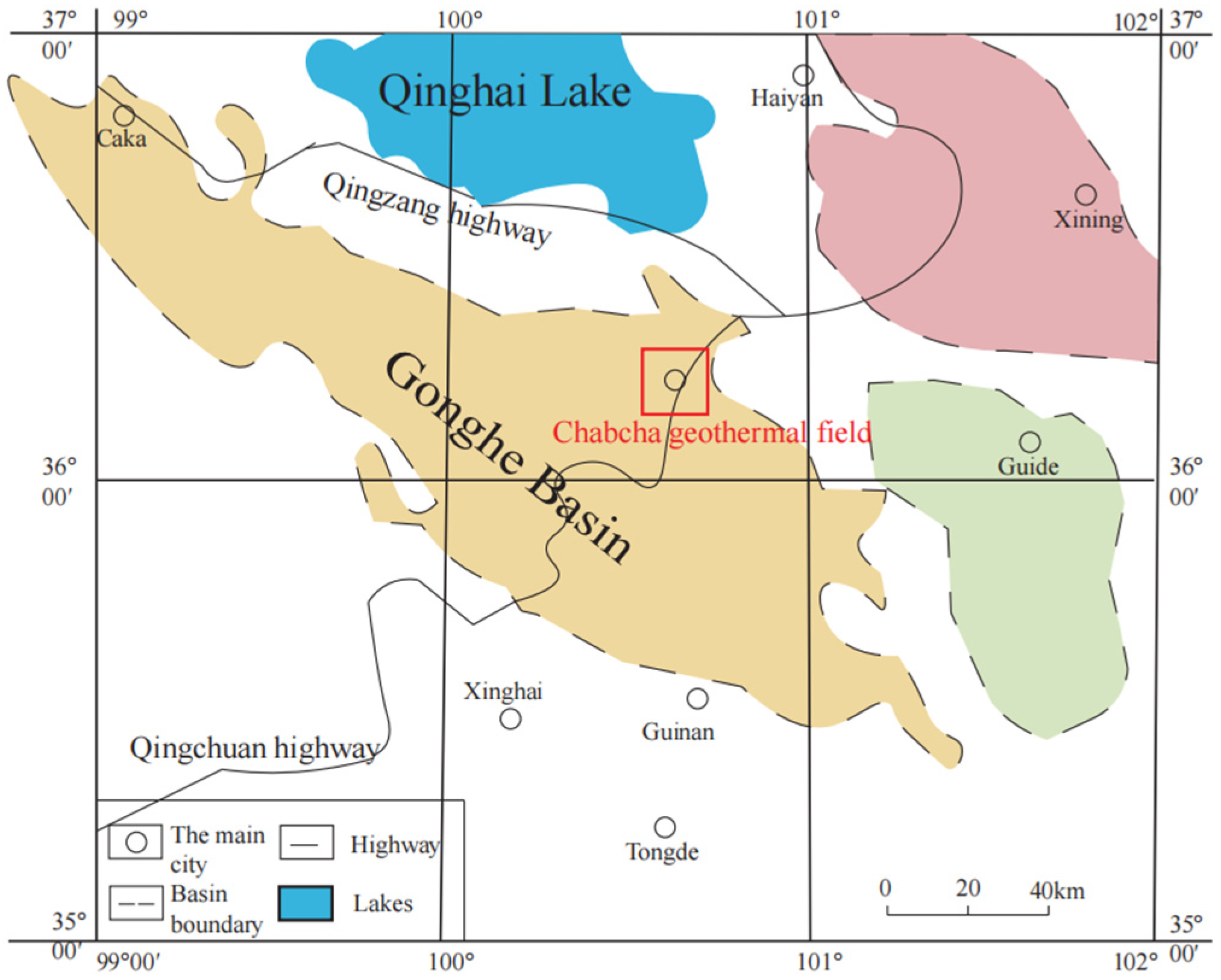
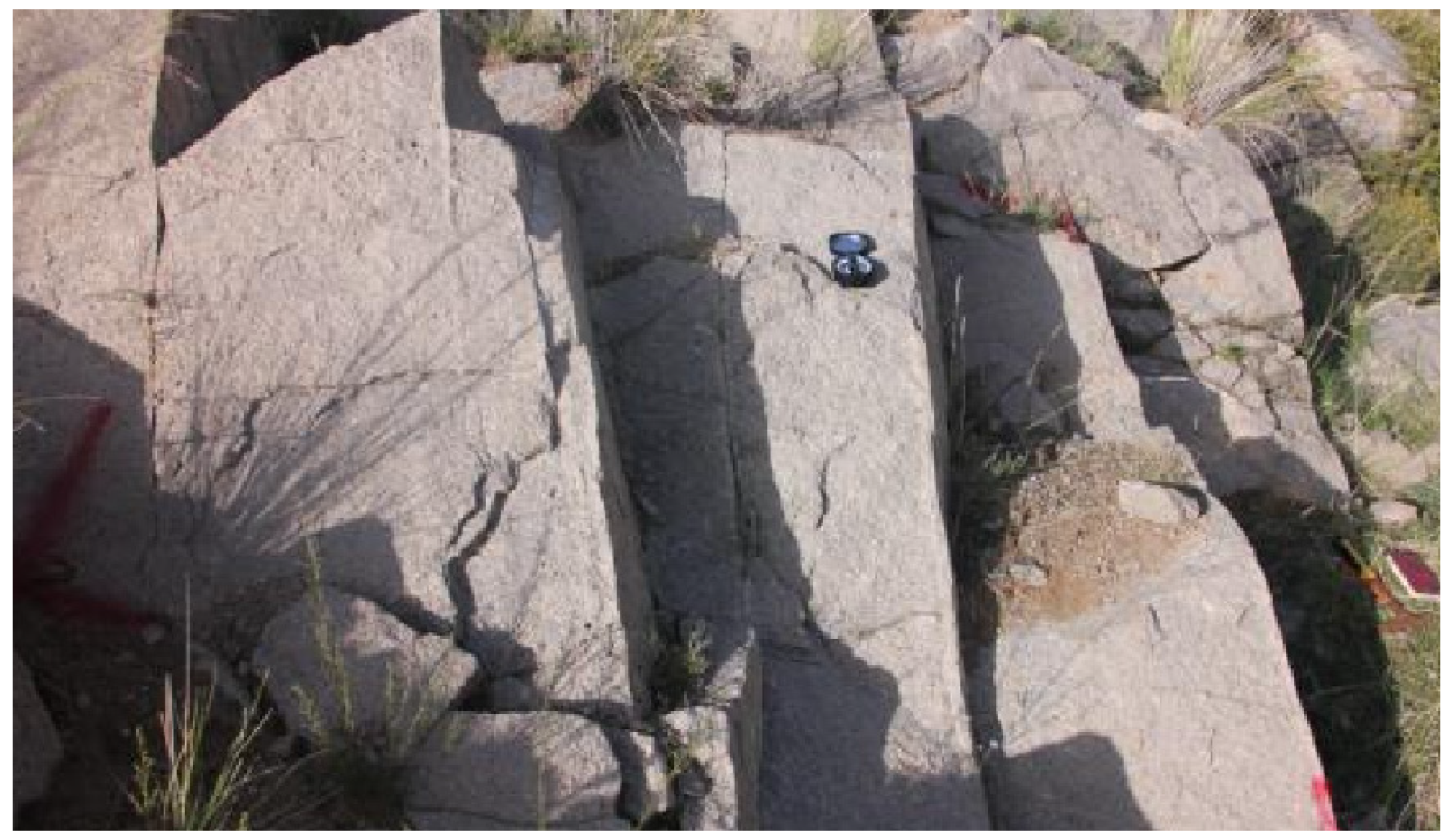


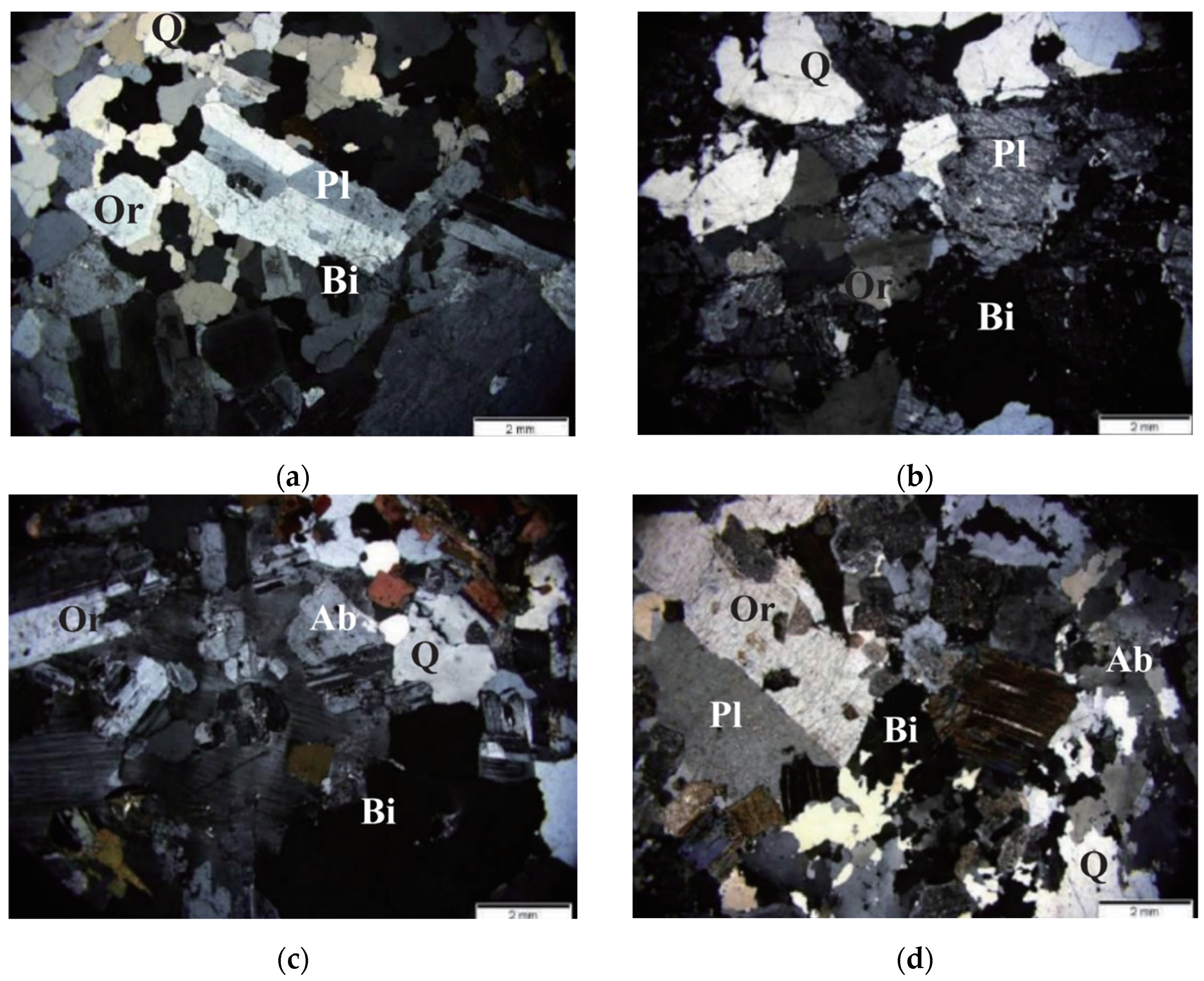

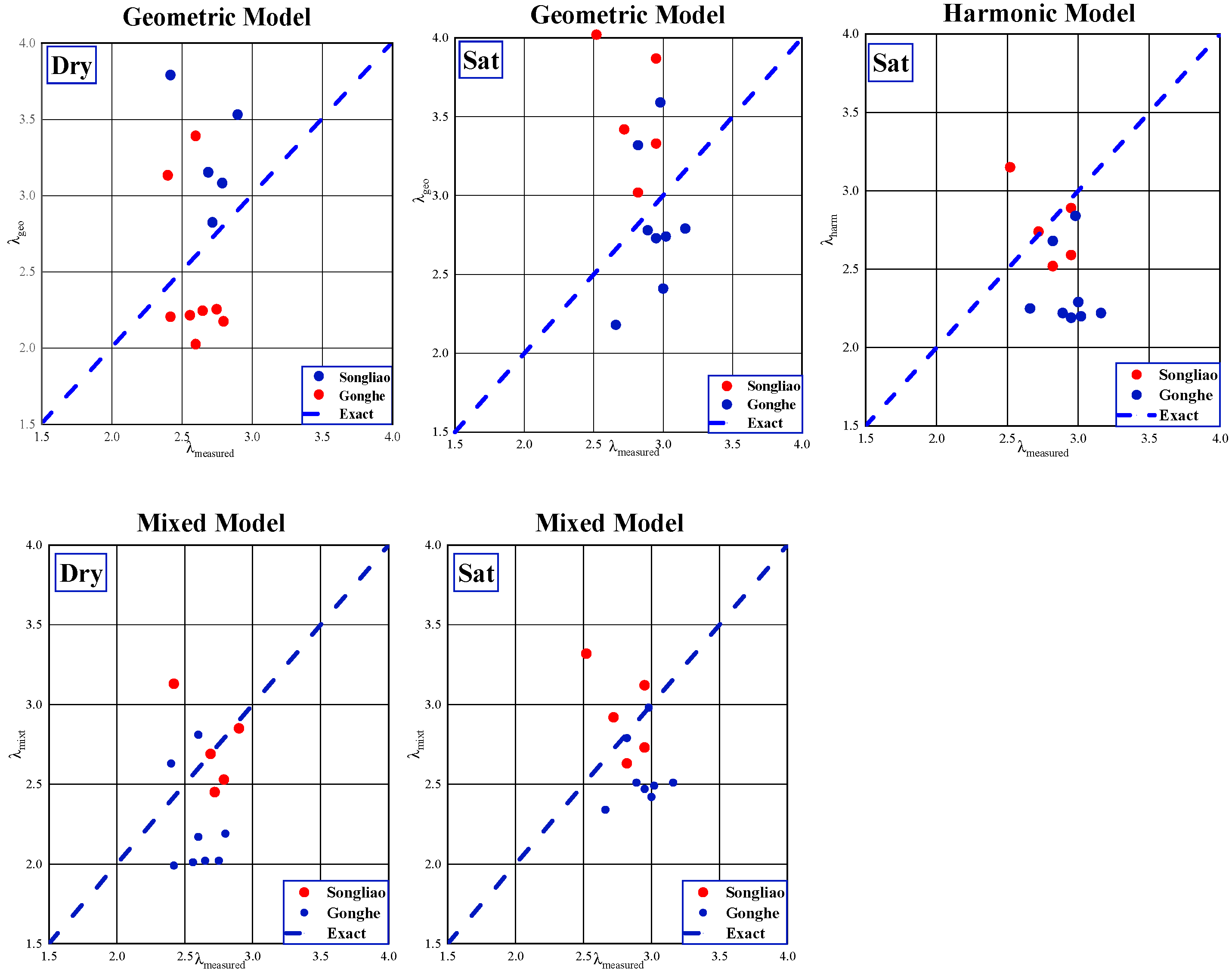
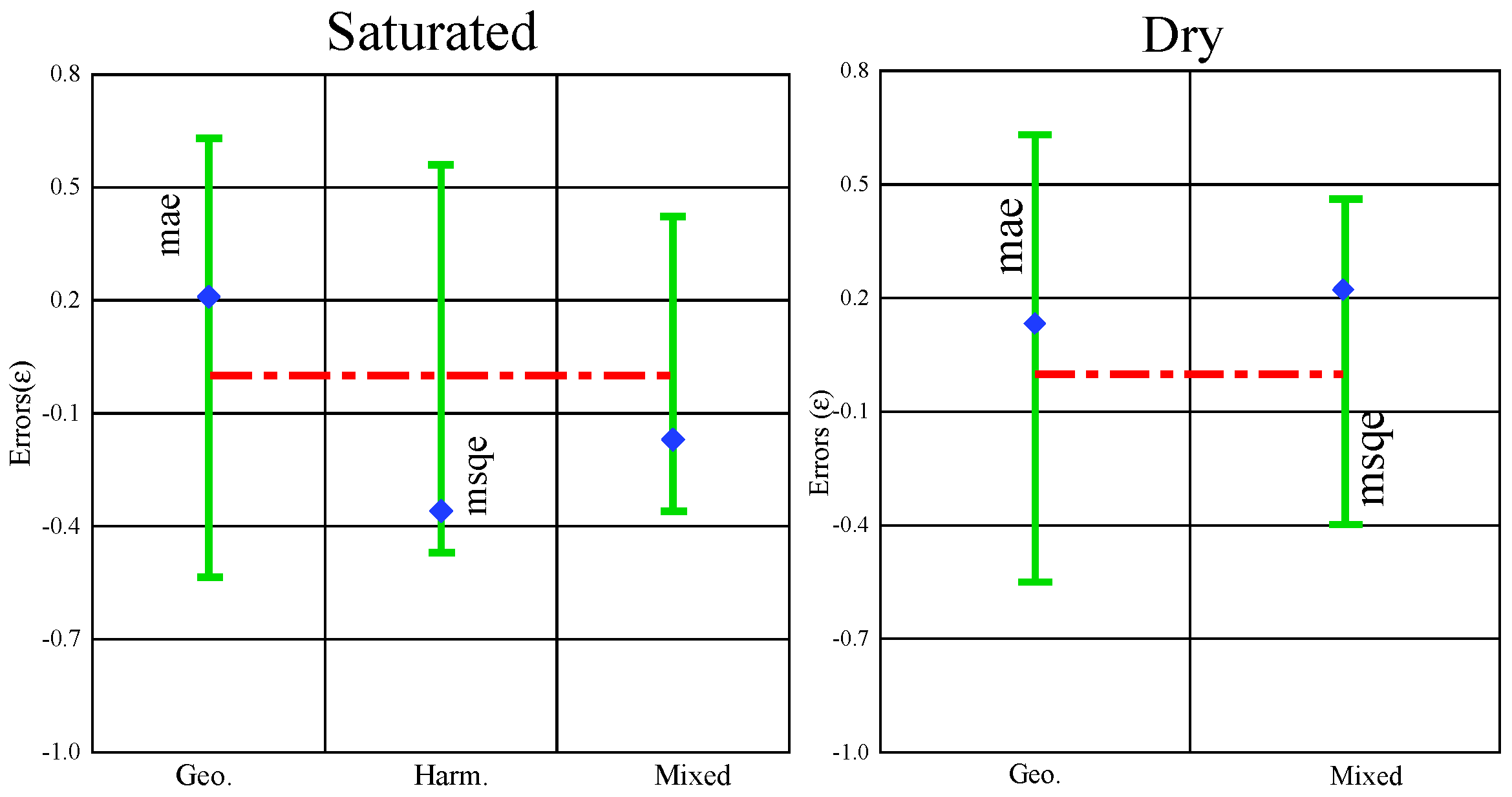
| Site | Rock Type | Serial Number | Relative Mineral Content (in vol %) | Measured | Geometric | Harmonic | Mixed | |||||||||||||||
|---|---|---|---|---|---|---|---|---|---|---|---|---|---|---|---|---|---|---|---|---|---|---|
| Qtz | Afs | Plag | Bi | Oth. | ||||||||||||||||||
| 7.70 | 2.30 | 1.80 | 2.13 | 2.17 | ||||||||||||||||||
| Son-gliao Basin | Granodiorite | SY05 | 42 | 12 | 34 | 12 | 0 | 2.58 | 2.79 | 2.95 | 3.48 | 3.08 | 0.29 | 3.33 | 0.38 | 2.84 | 2.59 | –0.36 | 2.73 | −0.22 | 2.53 | −0.26 |
| SY06 | 39 | 51 | 9 | 0 | 1 | 2.79 | 2.69 | 2.72 | 3.60 | 3.15 | 0.46 | 3.42 | 0.70 | 3.06 | 2.74 | 0.02 | 2.92 | 0.20 | 2.69 | 0.00 | ||
| SY07 | 52 | 30 | 11 | 2 | 5 | 1.92 | 2.42 | 2.52 | 4.17 | 3.79 | 1.37 | 4.02 | 1.50 | 3.43 | 3.15 | 0.63 | 3.32 | 0.80 | 3.13 | 0.71 | ||
| SY08 | 35 | 22 | 28 | 11 | 4 | 2.33 | 2.72 | 2.82 | 3.24 | 2.82 | 0.10 | 3.02 | 0.20 | 2.73 | 2.52 | −0.30 | 2.63 | −0.19 | 2.45 | −0.27 | ||
| Syenite | Gn-3 | 53 | 20 | 25 | 2 | 0 | 3.05 | 2.90 | 2.95 | 4.10 | 3.53 | 0.63 | 3.87 | 0.92 | 3.29 | 2.89 | −0.06 | 3.12 | 0.17 | 2.85 | −0.05 | |
| Gon-ghe Basin | Granodiorite | DR3-16 | 45 | 19 | 19 | 6 | 11 | 1.94 | 2.60 | 2.98 | 3.72 | 3.39 | 0.79 | 3.59 | 0.61 | 3.07 | 2.84 | −0.14 | 2.98 | 0.00 | 2.81 | 0.21 |
| GH-1 | 25 | 8 | 37 | 3 | 27 | 2.57 | 2.60 | 2.66 | 2.79 | 2.02 | −0.58 | 2.18 | −0.48 | 2.43 | 2.25 | −0.41 | 2.34 | −0.32 | 2.17 | −0.43 | ||
| GH-2 | 30 | 9 | 35 | 5 | 21 | 3.43 | 2.80 | 3.00 | 2.98 | 2.17 | −0.63 | 2.41 | −0.59 | 2.55 | 2.29 | −0.71 | 2.42 | −0.58 | 2.19 | −0.61 | ||
| Adame-llite | DR3-15 | 39 | 14 | 18 | 29 | 0 | 1.94 | 2.40 | 2.82 | 3.43 | 3.13 | 0.73 | 3.32 | 0.50 | 2.88 | 2.68 | −0.14 | 2.79 | −0.03 | 2.63 | 0.23 | |
| 1-600-01 | 26 | 69 | 0 | 5 | 0 | 7.18 | 2.65 | 2.89 | 3.13 | 2.24 | −0.41 | 2.78 | −0.11 | 2.80 | 2.22 | −0.67 | 2.51 | −0.38 | 2.02 | −0.63 | ||
| 1-600-02 | 24 | 73 | 0 | 3 | 0 | 7.18 | 2.42 | 2.95 | 3.07 | 2.20 | −0.22 | 2.73 | −0.22 | 2.76 | 2.19 | −0.76 | 2.47 | −0.48 | 1.99 | −0.43 | ||
| 1-600-03 | 25 | 71 | 0 | 3 | 1 | 7.18 | 2.56 | 3.02 | 3.08 | 2.21 | −0.35 | 2.74 | −0.28 | 2.78 | 2.20 | −0.82 | 2.49 | -0.53 | 2.01 | −0.55 | ||
| 1-600-04 | 26 | 70 | 0 | 4 | 0 | 7.18 | 2.75 | 3.16 | 3.14 | 2.25 | −0.50 | 2.79 | −0.37 | 2.80 | 2.22 | −0.94 | 2.51 | −0.65 | 2.02 | −0.73 | ||
| (msqe) | 0.62 | 0.63 | 0.55 | 0.42 | 0.46 | |||||||||||||||||
| (mae) | 0.54 | 0.53 | 0.46 | 0.35 | 0.39 | |||||||||||||||||
| (m) | 0.13 | 0.21 | −0.36 | −0.17 | −0.22 | |||||||||||||||||
| Site | Rocks Description | Rock Structure | Predominant Minerals | Description of Main Minerals | ||
|---|---|---|---|---|---|---|
| Shape | Particle Size | Characteristics | ||||
| Songliao Basin | fine and medium-grained biotite granodiorite (Figure 7a) | fine and medium-grained granite structure and a massive structure | Quartz | allomorphic granular | 4–7 mm | wavy extinction, and interference color is yellow and white |
| Plagioclase | semi-automatic plate shape | 3–6 mm | polysynthetic twin can be seen locally | |||
| Alkali feldspar | allomorphic granular | 3–6 mm | cassette double crystals and visible kaolinized alterations | |||
| Biotite | flakes | 0.25–1 mm | parallel extinction | |||
| fine-middle grain of syenogranite (Figure 7b) | fine-medium-sized semi-automorphic granular structure with massive structure | Quartz | allomorphic granular | 4–7 mm | wavy extinction, and interference color is yellow and white | |
| Plagioclase | semi-automatic plate shape | 2.5–5 mm | polysynthetic twin can be seen locally | |||
| Alkali feldspar | allomorphic granular | 3–6 mm | alkali feldspar content is about 20% | |||
| Gonghe Basin | fine-medium-grained chlorite biotite granodiorite (Figure 7c) | fine-grained granite structure and massive structure | Quartz | allomorphic granular | 4–7 mm | wavy extinction, and interference color is yellow and white |
| Plagioclase | semi-automorphic and automorphic column | 2.5–5 mm | polysynthetic twin can be seen locally | |||
| Alkali feldspar | allomorphic granular | 2.5–5 mm | striated feldspar and microcline feldspar | |||
| Biotite | scaly shape | 0.25–1 mm | under the cross polarizer, abnormal interference color of Prussian blue can be seen | |||
| fine-grained biotite-bearing granites (Figure 7d) | medium-fine semi-automorphic granular structure, massive structure. | Quartz | allomorphic granular | under 2 mm | wavy extinction, and interference color is yellow and white. | |
| Plagioclase | semi-automorphic and automorphic column | 2.5–5 mm | sericitization, and polysynthetic twin can be seen locally | |||
| Alkali feldspar | allomorphic granular | 2.5–5 mm | ||||
| Biotite | 0.25–1 mm | slight chlorination | ||||
Publisher’s Note: MDPI stays neutral with regard to jurisdictional claims in published maps and institutional affiliations. |
© 2022 by the authors. Licensee MDPI, Basel, Switzerland. This article is an open access article distributed under the terms and conditions of the Creative Commons Attribution (CC BY) license (https://creativecommons.org/licenses/by/4.0/).
Share and Cite
Ye, X.; Yu, Z.; Zhang, Y.; Kang, J.; Wu, S.; Yang, T.; Gao, P. Mineral Composition Impact on the Thermal Conductivity of Granites Based on Geothermal Field Experiments in the Songliao and Gonghe Basins, China. Minerals 2022, 12, 247. https://doi.org/10.3390/min12020247
Ye X, Yu Z, Zhang Y, Kang J, Wu S, Yang T, Gao P. Mineral Composition Impact on the Thermal Conductivity of Granites Based on Geothermal Field Experiments in the Songliao and Gonghe Basins, China. Minerals. 2022; 12(2):247. https://doi.org/10.3390/min12020247
Chicago/Turabian StyleYe, Xiaoqi, Ziwang Yu, Yanjun Zhang, Jianguo Kang, Shaohua Wu, Tianrui Yang, and Ping Gao. 2022. "Mineral Composition Impact on the Thermal Conductivity of Granites Based on Geothermal Field Experiments in the Songliao and Gonghe Basins, China" Minerals 12, no. 2: 247. https://doi.org/10.3390/min12020247
APA StyleYe, X., Yu, Z., Zhang, Y., Kang, J., Wu, S., Yang, T., & Gao, P. (2022). Mineral Composition Impact on the Thermal Conductivity of Granites Based on Geothermal Field Experiments in the Songliao and Gonghe Basins, China. Minerals, 12(2), 247. https://doi.org/10.3390/min12020247




